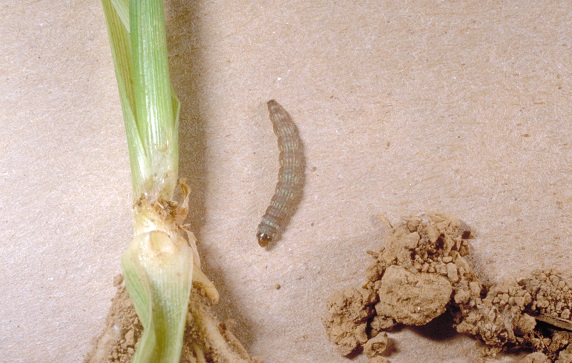Lesser Cornstalk Borer
ENTFACT-129: Lesser Cornstalk Borer | Download PDF
by Ric Bessin, Extension Specialist
University of Kentucky College of Agriculture
The lesser cornstalk borer is a sporadic pest that occasionally can attack late-planted seedling corn in dry years. The damage appears as a deadheart of the small seedlings and is similar to damage caused by wireworms. The first corn leaves appear normal, but the younger leaves emerging from the whorl wilt and die. The growing point of the plant is usually killed. The lesser cornstalk borer prefers corn, but also attacks soybeans, other beans, sorghum, wheat and Johnson grass. It attacks the plants from emergence on, but corn plants beyond the six leaf stage usually are not affected. This insect is common in the Atlantic and Gulf coast states.
Biology
The lesser cornstalk borer is recognized by having alternate bands of purple and green encircling its body. Small 3/4 inch larvae may be found tunneling into the stem of the plant. The larva remains in the soil in a silken tube just below the soil surface and injures plants by boring into and tunneling up the stem of the plant. When disturbed, the larva wiggles violently.

Figure 1. Lesser cornstalk borer feeds at the crown of developing corn seedlings.
Where lesser cornstalk borer is suspected, examine around the base of the corn for silken tubes which incorporate soil particles. If you find webs, pull them apart and look for a borer and examine the crown of the plant to determine whether damage is fresh. It may be necessary to remove some plants to examine them thoroughly. Although the damage may appear to be caused by wireworms, wireworms don't produce webbing. Silken webbing forming a small tube at the soil line is evidence of lesser cornstalk borer activity.
Lesser cornstalk borer overwinters as a larva or pupa. The moth emerges early in the spring and lay its eggs on the leaves or stems of plants. The small larva begins to feed on roots and leaves, later the larva constructs underground silken tubes at the soil surface from which they feed on plants. It becomes fully grown in 2 to 3 weeks after egg hatch, and pupates in silken cocoons under trash on the surface of the ground. The moth emerges from these cocoons in 2 to 3 weeks. Subsequent generations are not economically important.
Management
Serious damage by this insect is usually limited to late-planted corn grown in dry years on well- drained soils. Rainfall and irrigation will kill many larvae. Soil applied insecticides used at planting for corn rootworms or cutworms may control this pest. Where this insect has been a problem, careful inspection during the seedling stage is important, particularly in drought years. Damage can be reduced significantly by killing or eliminating weeds two weeks before planting. Weed elimination 10 to 14 days before planting also reduces the chances of losses due to black cutworm.
Rescue treatments are not effective with this insect. In a 1999 study at UK, Bt corn (YieldGard corn and Attribute sweet corn) was found to be highly resistant to this pest. The Bt corn reduced lesser cornstalk borer deadhearts by 88 percent.
Revised: 11/19
CAUTION! Pesticide recommendations in this publication are registered for use in Kentucky, USA ONLY! The use of some products may not be legal in your state or country. Please check with your local county agent or regulatory official before using any pesticide mentioned in this publication.
Of course, ALWAYS READ AND FOLLOW LABEL DIRECTIONS FOR SAFE USE OF ANY PESTICIDE!
Photos courtesy Ric Beesin, University of Kentucky Entomology
